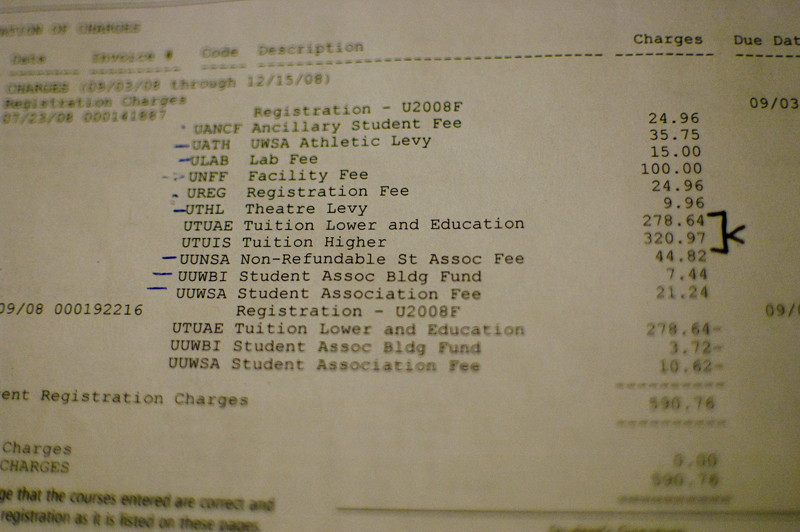Tuition fees: examined and explained
Tuition makes up a large part of university fees, but how much does a receipt explain?
Each year students pay their tuition without thinking much about where their money goes.
According to Michael Emslie, controller and executive director of financial services for the University of Winnipeg, student tuition receipts are fairly straightforward.
He explained that UWSA fees go to the University of Winnipeg Students’ Association, the athletic levy pays for the Duckworth Centre and access to the facilities, while registration fees go toward the cost of registering students.
When it comes to specific fees for course labs, the faculty and its students are not left out.
“Under each department there is student input of how to distribute the expendable lab fees,” he said.
According to Emslie, students’ involvement was made a stipulation by the Board of Regents a few years ago.
One thing that might not be as clear is the ancillary fee.
Emslie said that 20 per cent of it will go towards student scholarships, and the rest goes towards administrative fees of the university.
In terms of actual tuition, things are not so straightforward.
“A lot of the revenue that the university receives gets put into one general pot,” he said.
“Student tuition makes up for around 30 per cent of that revenue. The other parts are around 50 per cent operating grants the university receives from the provincial government, and the remainder is made up of donations, gifts, goods and services and research grants.”
The pot is distributed amongst building fees, taxes, supplies and scholarships but mainly it provides staff salaries and benefits, making up over 50 per cent of the pot.
There is no public information regarding how much of this is allocated to each staff member, be it administration, support staff or professors, but the majority of student tuition goes toward paying the people who contribute to providing education.
Manitoba’s tuition remains the lowest in the country even after the lift of the 10-year tuition freeze last year.
“Manitoba’s student debt is lower than the national average, and I think we can attribute that to the tuition freeze and keeping fees low,” said Alanna Mackinson, chairperson for the Canadian Federation of Students (CFS) Manitoba.
CFS is an organization focused on affordable and accessible education for all students, which is an ongoing struggle that the decade-long halt helped ameliorate.
“Under the freeze we saw a 33 per cent enrolment increase (and) a 60 per cent increase in public funding,” she said.
Rodney Clifton, an education professor at the University of Manitoba, agrees that a higher education can be achieved for lower tuition.
“Could we get better and more teaching for less? Yes. Our faculty just lowered our teaching responsibilities, but much more money is being put into administration,” he said.
Clifton, who is also a member of the Canadian Federation for Public Policy, thinks that universities should be focused on the needs of students rather than the needs of administrators. He noted that there is pressure on professors to not teach as much.
“Prestige in university is given to people who publish, rather than those who teach well,” he said. “If you look at where those (tuition) funds go, teaching is not given the same status as publishing.”
The University of Winnipeg’s financial statements are available for student and public viewing at www.uwinnipeg.ca/index/financial-srvs-statements.
Published in Volume 65, Number 5 of The Uniter (September 30, 2010)







